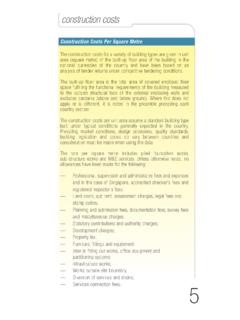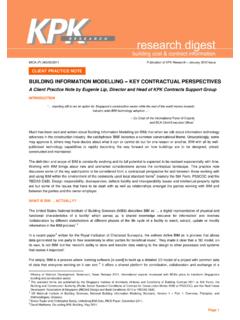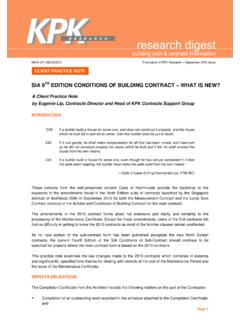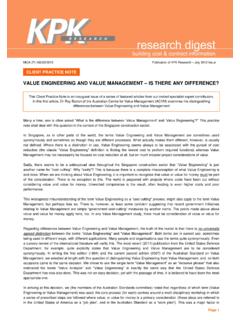Transcription of CLAIMS THE KEY ESSENTIALS [ PART 1 ] - kpkqs.com
1 Page 1 A Client Practice Note by Eugenie Lip, Director and Head of KPK Contracts Support Group CLAIMS THE KEY ESSENTIALS [ part 1 ] INTRODUCTION It is possible to fail in many ways .. while to succeed is possible only in one way Aristotle CLAIMS a word which means different things to different people and can cause emotional flare-ups, strained relations, endless exchanges of correspondence and considerable resources. Unsurprisingly, contract forms recognise and provide procedures to deal with CLAIMS by specifying the particular events upon which the adjustment to the completion time or additional payment can be sought, notices to be served and the evidential requirements so as to reduce them festering into disputes.
2 The commonly used standard forms published by the Singapore Institute of Architects (SIA Form), Real Estate Developers Association of Singapore (REDAS Design and Build Conditions or REDAS D&B) and the Building and Construction Authority (Public Sector Standard Conditions of Contract for Construction Works or PSSCOC) are no different. The word claim or CLAIMS appears almost 35 times in the SIA Form, about 70 times in the REDAS D&B and over 100 times in the PSSCOC, albeit mostly in the context of CLAIMS for monthly payments under the Building and Construction Industry Security of Payment Act (Cap. 30B). It has been said that CLAIMS are unavoidable and as ubiquitous as the hard hat in any construction project.
3 What causes them? Are they unavoidable? If CLAIMS are unavoidable, we should at least be in a position to deal with them effectively and expeditiously in a professional and disciplined manner. This practice note, the first of a two- part article, discusses the types of CLAIMS , their origins and bases and the procedures for CLAIMS within the contractual environment as set out in the SIA Form, REDAS D&B and PSSCOC. The second part of this article will examine the documentary evidence required and the approach in ascertaining a claim for loss and expense. TERMINOLOGY A claim has been defined as the assertion of a right to something. That something in the context of a building contract can be an extension of the contract period or the time for completion and/or additional payment or compensation arising under the express or implied provisions of the contract.
4 CLAIMS are commonly linked to or take the form of notices or applications for an extension of time or loss and expense which are given in compliance with the procedural requirements in the contract and must be observed if they are characterised by the words condition precedent . CLAIMS must be distinguished from disputes and variations. When the Contractor makes a claim , he is simply putting forward a statement on his contractual entitlement and does not mean that a dispute has crystallised. However, if the claim is not accepted or there is failure to reach consensus on the entitlement, it may become a dispute. Variations or scope changes are necessary to respond to unforeseen circumstances, new or revised requirements, changes in quantity, quality and character or compliance with amended or the latest regulations, bye-laws or legislation.
5 Variations can manifest into CLAIMS when the Contractor believes he has a contractual entitlement to an extension of time and/or additional payment which he could not be sufficiently compensated under the contractual machinery for valuing variations. MICA (P) 186/03/2010 Publication of KPK Research January 2011 Issue CLIENT PRACTICE NOTE CLAIMS THE KEY ESSENTIALS [ part 1 ] A Client Practice Note by Eugenie Lip, Director and Head of KPK Contracts Support Group Page 2 A Client Practice Note by Eugenie Lip, Director and Head of KPK Contracts Support Group CLAIMS THE KEY ESSENTIALS [ part 1 ] CATEGORIES OF CLAIMS Contractual CLAIMS These are CLAIMS arising under the express provisions of the contract and the precise wording of the respective clauses governs the protocol for such CLAIMS .
6 For example, in the SIA Form, Clause 23 sets out the delaying events and the procedure and time limits for notices and assessment of the amount of extension of time. CLAIMS for extension of time and additional payment under REDAS D&B are respectively dealt with in Clauses 16, 17 and 18 and Clause 29. In PSSCOC, time extension CLAIMS and CLAIMS for loss and expense can be found in Clause 14 and Clauses 22 and 23 respectively. Common law CLAIMS Sometimes called ex contractual or extra contractual CLAIMS , they arise outside the express provisions of the contract. Common law CLAIMS are CLAIMS for breach of contract at common law or some other aspect of the law, for example in tort or breach of copyright.
7 Quantum meruit CLAIMS The expression quantum meruit means what one has earned or amount he deserves . A quantum meruit claim arises when work has been carried out but no price has been agreed either in the contract or due to failed negotiations and an agreement was not reached. In British Steel Corporation v Cleveland Bridge & Engineering Co Ltd (1983) 24 BLR 94, the plaintiff sub-contractor succeeded in their quantum meruit claim for work done on a letter of intent. No contract existed between the parties although some 230,000 worth of work had been carried out. Ex gratia CLAIMS These CLAIMS are those which the Contractor has no legal entitlement but made on hardship grounds.
8 They are sometimes called sympathetic CLAIMS . Such CLAIMS are put forward by a Contractor as a last resort when he has suffered a significant loss through no fault of the Employer. Ex gratia CLAIMS are seldom met by the Employer unless some benefit or advantage accrues for him to accede to payment. A case in point was the sharp surge in the price of sand in 2007 consequent on the export ban by Indonesia which caught many by surprise. With most projects being fixed-price contracts where the risk ownership of fluctuations in the prices of materials lies with the Contractor who assumes full responsibility for all input price changes and for inflation, developers were encouraged to accept an ex gratia cost-sharing regime with contractors to alleviate the burden in the increase of the price of sand.
9 WHAT DO THE CONTRACT FORMS SAY? Most contract forms set out the procedural requirements for the notices to be given, specific time limits to make a claim and the evidential records to substantiate it. SIA Form In respect of breach of contract by the Employer, the Contractor has two possible heads of claim a claim for extension of time and a claim for damages or loss and expense. Decisions on time CLAIMS fall within the power of the Architect under Clause 23 and in particular, Clause 23.(1)(p) where the Contractor can apply for an extension of time as a result of any act of prevention or breach of contract by the Employer . With regard to CLAIMS for loss and expense suffered by the Contractor including any loss of profit on other business or contracts from breach of contract by the Employer, in the absence of any express provision, the Architect has no power to decide or certify through the contractual process as provided under Clause 31.
10 (14). The Contractor has to pursue an action for general damages under common law. Examples of breach of contract by the Employer under Clause 31.(14) are for illustrative purposes and should not be read as exhaustive as to what acts or omissions amounts to breach of contract and can be construed to include the breach of any provision in the contract by the Employer. The rationale behind the limitation on the Architect s powers can be gleaned from the Guidance Notes on the SIA Form where the draftsman of the contract form articulated that it was not thought desirable to make the Architect judge, even temporarily, in what will usually be his own cause 1. Under such circumstances, it would not be appropriate for the Architect to decide or certify any such CLAIMS .





